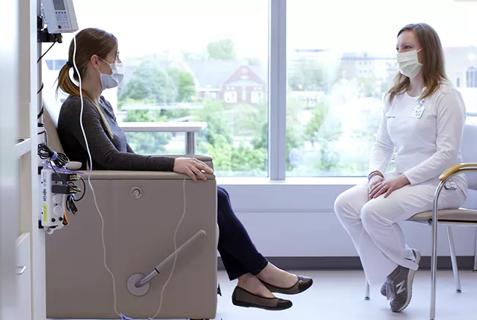A hematologist wrestles with how to help leukemia patients make the right treatment choices

By Mikkael Sekeres, MD, MS
Advertisement
Cleveland Clinic is a non-profit academic medical center. Advertising on our site helps support our mission. We do not endorse non-Cleveland Clinic products or services. Policy
In my outpatient exam room, we had arrived at that moment of silence that often marks the crossroads of unwelcome news and a difficult decision.
My patient, in his mid-60s, had endured a five-week hospitalization after he learned he had leukemia, a period of time that included expected complications of chemotherapy. Week by week, as he returned to my clinic, he became stronger and gained weight, and color had even returned to his cheeks – markers of vitality that my mother might cite, but that also have relevance for those of us who claim only objective assessments of health.
Unfortunately for my patient, though, the numbers didn’t lie. His blood counts failed to recover, and when we performed a bone marrow biopsy to determine why, the results showed that his leukemia persisted.
“I’m not ready to die yet. I want the chemo,” my patient said. I asked him to take some time to think and to talk it through with his wife and his family. He was resolute though, and we admitted him to the hospital the following day. Two weeks later, he died of an uncontrollable infection, on a breathing tube in the intensive care unit.
I was left wondering, not for the first time in my career, if I had launched someone on a path toward premature death. At the very least, I was guilty of that act of hubris of which oncologists are often accused: giving chemotherapy to a person only days before his death.
Read the full New York Times column by Dr. Sekeres, Director of Cleveland Clinic’s Leukemia Program.
Advertisement
Photo Credit ©Russell Lee
Advertisement
Advertisement

Palliative and Supportive Care Teams offer comprehensive care to improve the lives of patients facing cancer

Newer medications pivotal for improving gastrointestinal symptoms in patients with cancer

Helping patients with cancer struggling with depression, anxiety and other mental health issues

Majority of 1,000 patients seen in 2022 discharged home

Identifying the underlying cause key to successful treatment

Patient resources promote healthy living, management of late and long-term side effects

Research and clinical experience indicate that hyperthermia boosts the efficacy of radiotherapy

Reducing uncollectible revenue, financial burden